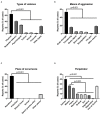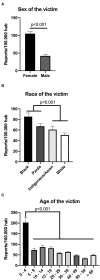Socioeconomic Factors Associated With Reports of Domestic Violence in Large Brazilian Cities
- PMID: 33604324
- PMCID: PMC7884961
- DOI: 10.3389/fpubh.2021.623185
Socioeconomic Factors Associated With Reports of Domestic Violence in Large Brazilian Cities
Abstract
Background: Domestic violence is a traumatic experience that can lead to physical consequences, mental disorders and financial damage. Over 18 cases per 100,000 inhabitants were reported in Brazil between 2013 and 2014. The ministry of health poses a mandatory notification of all cases of domestic violence, which is essential, bearing in mind its systemic relation to various social issues and the extensive regional differences and high socioeconomic inequalities present in Brazil. Aim: To analyze the characteristics of the notification rates of domestic violence and investigate the correlation of these with health and socioeconomic characteristics of large Brazilian cities. Methods: Retrospective data on notifications of domestic violence was collected from the National Information System for Notifiable Diseases for Brazil, 2017. Dependent variables were collected from the Brazilian Institute of Geography and Statistics and Ministry of Citizenship. Inclusion criteria were: cities larger than 100.000 habitants and that had at least 20 reports, totaling 68.313 reports in 259 cities. These were stratified by age, race and sex of victim, type of violence used, violence perpetrator, place of occurrence and means of aggression. Proportional number of notified cases was calculated for each city to expose different characteristics of reports. A multiple linear regression model was used to investigate the correlation between report rates and different socioeconomic and health variables. Results: The analysis showed a high proportion of repeated violence, use of body strength and over 50% were perpetrated by a partner or boyfriend. Report rates were higher for women, black individuals and children under four, highlighting subgroups of the population that were more vulnerable. Indeed, these groups were correlated differently with socioeconomic variables. Poverty, assessed as Bolsa Família investment, was correlated with domestic violence report rates across vulnerable groups. Conclusion: The study showed that black women and children are more vulnerable to domestic violence, highlighting deleterious effects of patriarchy and structural racism within Brazilian society. Altogether, we suggest that reducing poverty, patriarchy and structural racism could lead to fewer cases of domestic violence.
Keywords: Brazil; domestic violence; gender-based violence; mandatory reporting; racism.
Copyright © 2021 Pereira and Gaspar.
Conflict of interest statement
The authors declare that the research was conducted in the absence of any commercial or financial relationships that could be construed as a potential conflict of interest.
Figures


Similar articles
-
Epidemiological and spatial characteristics of interpersonal physical violence in a Brazilian city: A comparative study of violent injury hotspots in familial versus non-familial settings, 2012-2014.PLoS One. 2019 Jan 7;14(1):e0208304. doi: 10.1371/journal.pone.0208304. eCollection 2019. PLoS One. 2019. PMID: 30615621 Free PMC article.
-
Domestic violence and social norms in Norway and Brazil: A preliminary, qualitative study of attitudes and practices of health workers and criminal justice professionals.PLoS One. 2020 Dec 4;15(12):e0243352. doi: 10.1371/journal.pone.0243352. eCollection 2020. PLoS One. 2020. PMID: 33275624 Free PMC article. Clinical Trial.
-
Alcohol-related domestic violence: a household survey in Brazil.Rev Saude Publica. 2009 Oct;43(5):743-9. doi: 10.1590/s0034-89102009005000049. Epub 2009 Sep 4. Rev Saude Publica. 2009. PMID: 19722004 English, Portuguese.
-
Mental and physical health effects of intimate partner violence on women and children.Psychiatr Clin North Am. 1997 Jun;20(2):353-74. doi: 10.1016/s0193-953x(05)70317-8. Psychiatr Clin North Am. 1997. PMID: 9196919 Review.
-
Orthopaedic surgeons can play important role in identifying victims of domestic violence in the emergency department - narrative review of Brazilian literature.Medicine (Baltimore). 2022 Dec 16;101(50):e31461. doi: 10.1097/MD.0000000000031461. Medicine (Baltimore). 2022. PMID: 36550911 Free PMC article. Review.
Cited by
-
Domestic violence and its determinants among reproductive-age women in Sub-saharan Africa: a multilevel analysis of 2019-2024 demographic and health survey data.BMC Public Health. 2025 Jul 2;25(1):2288. doi: 10.1186/s12889-025-23544-z. BMC Public Health. 2025. PMID: 40604804 Free PMC article.
-
Mental Health of Women Affected by Gender-based Violence: A Neglected Public Health Domain.Indian J Community Med. 2025 Mar-Apr;50(2):271-273. doi: 10.4103/ijcm.ijcm_708_23. Epub 2025 Jan 30. Indian J Community Med. 2025. PMID: 40384839 Free PMC article.
-
Association between intimate partner violence and depressive symptoms across household wealth levels in women of reproductive age in Peru.Womens Health (Lond). 2025 Jan-Dec;21:17455057251351410. doi: 10.1177/17455057251351410. Epub 2025 Jul 6. Womens Health (Lond). 2025. PMID: 40618231 Free PMC article.
References
-
- Minayo MC, de S. Violência e saúde. 1st ed Rio de Janeiro: Editora Fiocruz; (2006).
-
- Sarmiento YA, Rodríguez DL, Leyva TF, Mendoza YRM. Family violence. Int J Heal Med Sci. (2019) 2:17–25. 10.31295/ijhms.v2n1.81 - DOI
-
- WHO World Report on Violence and Health. Geneva: WHO; (2002).
-
- Wallace PH, Roberson C. Characteristics and consequences of family violence. In: Wallace PH, Roberson C, editors. Family Violence: Legal, Medical and Social Perpectives. New York, NY: Routledge; p. 1–46.
-
- Smith-Marek EN, Cafferky B, Dharnidharka P, Mallory AB, Dominguez M, High J, et al. Effects of childhood experiences of family violence on adult partner violence: a meta-analytic review. J Fam Theory Rev. (2015) 7:498–519. 10.1111/jftr.12113 - DOI
MeSH terms
LinkOut - more resources
Full Text Sources
Other Literature Sources

